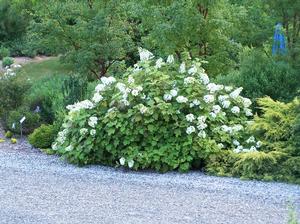
Hydrangea quercifolia is indigenous to the southeastern part of the U.S. It is native there. And though hardy much farther north than its indigenous range Oak-leaf Hydrangea is not a native plant in New England. We can grow it but it is not native.
What is a Native Plant
What is a native plant? If you were to poise this question to a group of green industry professionals you would likely hear a range of responses. It is unfortunately true that the term "native" is fraught with definitional difficulty. There are some who will loosely define a native plant as one which will grow in a garden or habitat far away from its actual native range. However, this assertion blurs the lines of reason and only injects unwarranted and unnecessary misconceptions into the horticultural lexicon.
A definition of native, one with greater circumspection and accuracy, is an indigenous plant, one originating in a given geographical area, a naturally occurring regional or endemic wild species, one component in the mix of an evolving localized wild habitat devoid of man's influence.
That said, many plants harbor genetic hardiness which extend grow-ability outside of the naturally occurring environment in which they have evolved. But just because genetic hardiness would allow that a species be planted and survive outside the boundaries of it actual natural nativity would in no way translate into a native designation.
Let us consider the example of Oakleaf Hydrangea. This beautiful hydrangea species originates in the southeastern United States. Oakleaf Hydrangea grows most often in the habitat of mixed hardwood forests along streams and on forested hillsides, usually but not always in lime-laden soils. It is a shrub most often associated in the understory shade provided by large oaks, hickories, magnolias, American beech, etc. Michael Dirr in his Manual of Woody Landscape Plants posits unabashedly and correctly that the "native range" of Oakleaf Hydrangea is Georgia, Florida, Alabama and Mississippi.
But Hydrangea quercifolia, the beautiful Oakleaf hydrangea, with its extraordinary ornamental attributes is hardy through USDA climate zone 5 which includes much of southern New England. Some forms may actually be hardy into USDA climate zone 4b (-25F). This species does grow, and quite well for us, in northeastern Connecticut. In that it will grow in our gardens so much farther north than its natural range some green industry professionals would define Hydrangea quercifolia as "native". It is not, not by hundreds of miles. And the reason is simple. Oakleaf Hydrangea is not naturally present in our forest mix nor found naturally in any wild habitat anywhere in southern New England. Oakleaf Hydrangea is, therefore, not native for us. Hardy? Yes. Native? No.
I am going to recommend a more sensible horticultural designation, that Hydrangea quercifolia, though non-native is a "near native". This more clearly defines meaning. Oakleaf Hydrangea is a plant that though it does not occur naturally in any southeastern New England habitat is, nevertheless, hardy for us and can be grown outdoors in eastern Connecticut hundreds of miles away from its actual nativity.
There are industry folk who will unthinkingly make the claim that Redbud is native in New England. This lovely small tree which has evolved in a broad swath of North America hales from New Jersey to Northern Florida, west to Missouri and Texas and into northern Mexico according to Michael Dirr in his botanical bible for plant geeks, "Manual of Woody Landscape Plants". The USDA claims that Cercis candadensis occurs in up to 3 of the 8 counties in Connecticut. When last I checked Redbud is not part of our deciduous woodland mix in eastern Connecticut. Redbud, though hardy for us in our gardens (at least forms of northern provenance - those with cold hardy genetic capability) is not genuinely native to eastern Connecticut. Redbud, Cercis canadensis, may eventually self-sow in eastern Connecticut as climate change progresses. In that Redbud grows as geographically nearby as New Jersey it is arguably even more "near native" than is Oakleaf Hydrangea. I propose dubbing the wonderful tree known as Redbud with the more correctly applicable term "near native", at least to those of us living in eastern Connecticut. Whether or not it actually occurs in 3 western Connecticut counties is debatable. Dirr indicates "no" while the USDA says "yes". I have no confirmation from nurseries in western Connecticut as to its possible indigenous status.
Is "near native" a perfect term? No. Will a better definition for native arise? Many who are far brighter than I may work out that puzzle. Near native does, however, lighten the shade of gray-purple foisted upon students and customers alike by green industry professionals. Educators and nursery owners must hone a better, more truthful, thoughtful and concise definition of what a native plant is. Less well-conceived definitions only add confusion to an industry already replete with all manner of bad usage and poor coinage. Let confusion not reign supreme!
penned by Wayne Paquette, January 2012